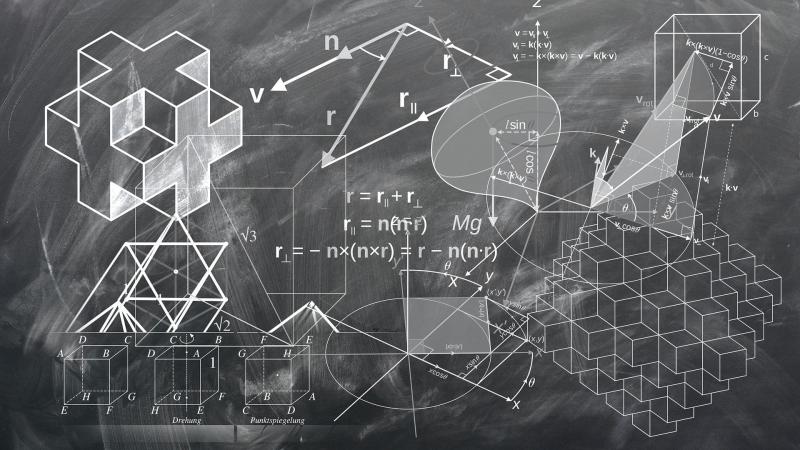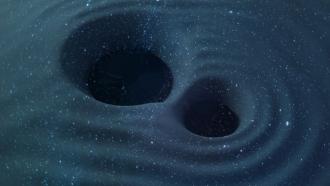
We all know that the geometric object of minimal surface area amongst all shapes with a fixed volume is the round ball, whose boundary is spherical. Water blobs try to minimise surface area and curl into spherical droplets. The physical problem of surface-area minimisation is thus quite well understood. What about the opposite problem of surface-area maximisation? Does the problem even make sense? Indeed it does. Trees try to maximise surface area to get the most of sunlight through their leaves. Sea anemones and sponges work to maximise their surface area to maximise contact with water to obtain food. Gills in fish and animal lungs try to maximise the surface area so that more oxygen goes into the blood. The resulting geometry is hyperbolic—a geometry that is, as expected, quite the opposite to spherical geometry.
The mathematical origins of hyperbolic geometry go back to a problem posed by Euclid around 200 B.C. It read, "Prove the parallel postulate from the remaining axioms of Euclidean geometry." This problem occupied the best mathematical minds for two millennia. Finally, in an unpublished work, Gauss (1824) solved the problem. Soon after, Janos Bolyai, a Hungarian mathematician, and Nikolai Lobachevsky, a Russian mathematician, unaware of Gauss’ work, solved the problem independent of each other. The solution turned out to be entirely unexpected. They remarked that the parallel postulate could neither be proved nor disproved, assuming only the remaining axioms of Euclidean geometry.
This solution is a fundamental logical conundrum and reflects in one of the most profound theorems of mathematical logic, called Godel’s incompleteness theorem. It states that in any sophisticated axiomatic mathematical system, there are always statements that can neither be proved nor disproved.
So, how does one relate the esoteric mathematical concerns of such theorems to the more intuitive problem of surface area maximisation we started with? The connecting link is given by a negative curvature, a feature that shows up locally as saddle-points. A surface is negatively curved if every point looks like a saddle-point. It is precisely the opposite of the shape of a sphere, where at every point, there is positive curvature.
A way of thinking about curvature is to think of triangles. In Euclidean space, the sum of the angles of a triangle equals 180 degrees. On the sphere, the sum of the angles of a triangle exceeds 180 degrees; so triangles are fatter. In a negatively curved space, triangles are skinnier—the sum of the angles of a triangle is less than 180 degrees. It is not hard to see that the parallel postulate is equivalent to the statement that the sum of the angles of a triangle equals 180 degrees. Thus, its failure is what ushers in negative curvature, and the resulting geometry is called hyperbolic geometry.
The more synthetic and intuitive approach to hyperbolic geometry, as stated above, was initiated by Jules Henri Poincare in two-dimension in the late 19th century. In the 1970s, the field saw an explosion of sorts due to some path-breaking work of William Thurston in three-dimension. Misha Gromov, around the same time, gave a very general description of hyperbolic geometry even in spaces where angles do not make sense. Spaces are Gromov-hyperbolic if triangles are skinny. Equivalently, they behave like trees in terms of their intrinsic geometry.
This explanation takes us back to where we started in terms of hyperbolic geometry occurring in nature. Well, there is a caveat. A theorem due to David Hilbert, from the early 20th century, says that if you try to fit negative curvature into Euclidean space, you are going to be forced to have boundaries. Mathematically, we assume that no complete space of negative curvature embeds in a distance-preserving way into our Euclidean space. This tension between Euclidean geometry and hyperbolic geometry shows up in the existence of fractals.
When some structure tries to maximise surface area, it tries to divide fast—imagine a tree branching to maximise the area of contact of its foliage with the atmosphere. The telltale trace of the geometry that results from this subdivision is a fractal in one lower dimension. Thus, the surface of the tree’s foliage is highly crinkled. Turning this viewpoint around, we realise that whenever we see a fractal in Euclidean space, it hints at the existence of hyperbolic geometric phenomena in one more dimension. In the specific context of three-dimensional hyperbolic geometry, Thurston had conjectured a precise connection between hyperbolic geometry and chaotic dynamics on fractals in two dimensions. We now know that this conjecture is true.
Well, where do we go from there? As we have pointed out, fractals or highly crinkled surfaces hint at the existence of hyperbolic geometry in three dimensions. One example of a highly crinkled surface is the surface of the human brain. It has hills and valleys called gyri and sulci. We are therefore tempted to believe that the body of the human brain very likely has hyperbolic geometry built into it. One way to model the brain is by a graph—vertices correspond to neurons and edges correspond to connections between them. Since the number of neurons in the brain is enormous, it would not be far wrong to assume that the number is infinite. The surface of the brain would then appear as the fractal boundary at infinity of the hyperbolic geometry of the three-dimensional body of the human brain. Can one deduce its internal geometry by studying the fractal nature of its surface? What is the precise connection between the geometry of the brain and the shape of its surface? These are questions that, as of now, have answers locked up in the womb of the future; it would be thrilling if we could take a peek.
This article is the last of a three-part series from leading Indian researchers on the unsolved challenges in the field of mathematics and science as they find solutions to them. This article is attributed to Prof. Mahan MJ, Professor, School of Mathematics, Tata Institute of Fundamental Research, Mumbai. Prof. Mahan MJ was awarded the Infosys Prize for Mathematics in 2015. The article series has been facilitated by Infosys Science Foundation.
This article has been minoroly edited to correspond to the editorial guidelines of Research Matters.






